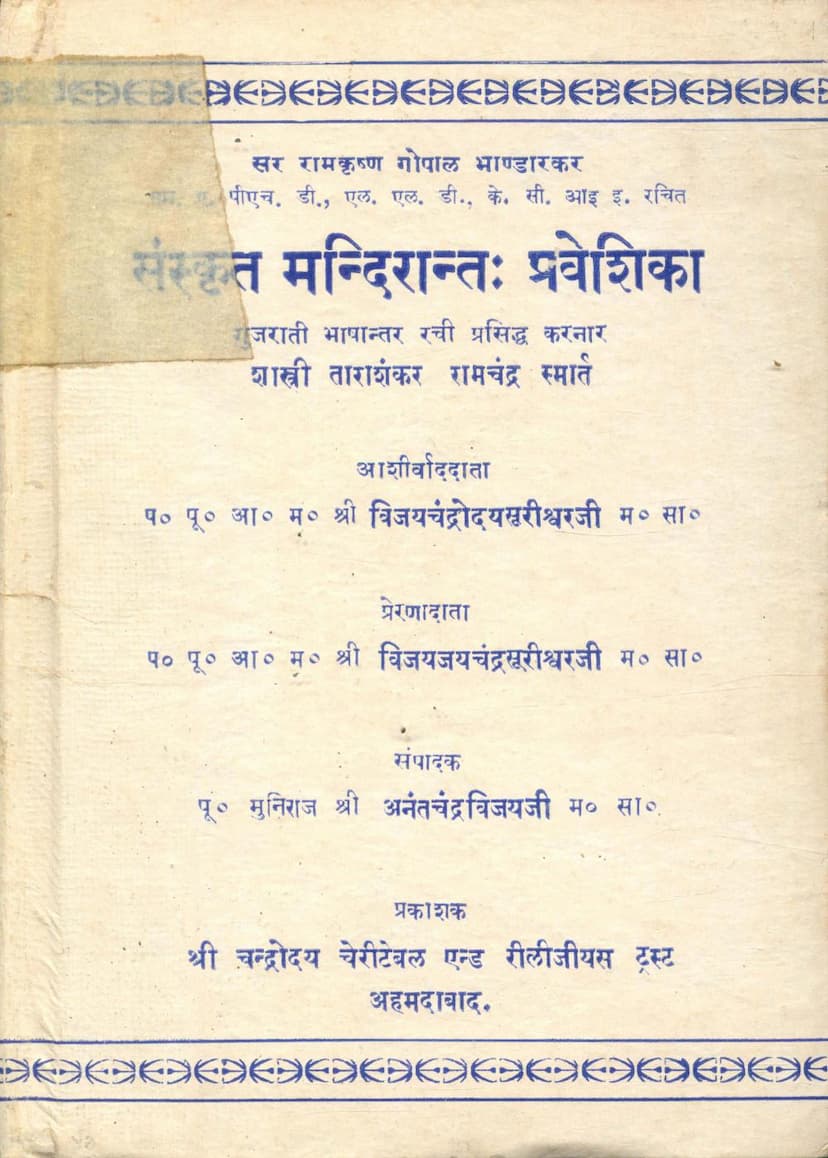Sanskrit Mandirant Praveshika
Added to library: September 2, 2025

Summary
Here's a comprehensive summary of the Jain text "Sanskrit Mandirant Praveshika" by Anantchandravijay, based on the provided pages:
Title: Sanskrit Mandirant Pra.veshika (Sanskrit Temple Entrance Guide) Author: Muni Shri Anantchandravijayji M. Sa. (Editor) Publisher: Shri Chandroday Charitable and Religious Trust, Ahmedabad Year of Re-publication: Vikram Samvat 2046 / AD 1990 Original Work: Composed by Sir Ramkrishna Gopal Bhandarkar, Ph.D., LL.D., K.C.I.E.
Overall Purpose: The book is a Gujarati translation of Sir Ramkrishna Gopal Bhandarkar's work, aiming to make the study of Sanskrit accessible and engaging, particularly for Gujarati-speaking students. It serves as an introductory guide to the Sanskrit language, focusing on grammar and vocabulary, with a strong emphasis on its connection to Indian culture and Jain traditions.
Key Themes and Content:
-
Introduction to Sanskrit: The text highlights the significance of Sanskrit as the "mother of all languages" and the carrier of Indian culture. It acknowledges the current challenges faced by Sanskrit education in India, where efforts were allegedly being made to distance students from the language, potentially to promote Western (Christian) culture. The publication of this book is presented as a mission to keep Sanskrit alive and promote its study.
-
Inspiration and Context: The publication of this specific edition is deeply rooted in Jain religious events and the inspiration derived from prominent Jain Acharyas.
- It was published in memory of significant spiritual observances, including the celebration of the 9th birth centenary of Acharya Shri Hemchandracharya.
- A key event mentioned is the community's arduous "Siddhitap" (a specific type of ascetic practice) performed by 117 individuals during the Chaturmas of Acharya Shri VijayNemisurishwarji M. Sa. and his disciples in Rajnagar, Ahmedabad. Muni Shri Anantchandravijayji himself participated in this tapasya.
- The text details the associated religious festivals, including the Panchahnika Jinendrabhakti Mahotsav, Shri Vishwashanti Vidhayak Shri Arihant Mahapujan, a grand Rath Yatra, Shri Samuhik Gnanpujan, and the worship of all ascetics.
- The book acknowledges the presence and support of many respected Acharyas, religious figures, and prominent community members and donors who contributed to these events and the publication itself.
-
Grammatical Focus (Based on Chapters and Word Lists): The bulk of the book is dedicated to teaching Sanskrit grammar and vocabulary. The detailed table of contents and chapter titles reveal a systematic approach:
- Verb Roots (Dhatus): The text meticulously categorizes and explains verb roots across various " ganas" (classes of verbs). It delves into irregular verb conjugations, present tense forms, imperative mood, past tenses (like hyastan), and subjunctive moods.
- Nouns and Adjectives: Chapters cover the formation of comparative and superlative forms of adjectives, and various types of compound words (Samasa), including Tatpurusha, Bahuvrihi, and Avyayibhav Samasa.
- Tenses and Moods: Specific lessons are dedicated to different verb tenses (present, past, future) and moods (imperative, potential/optative).
- Word Formation: It explains the role of prefixes (upasargas) in changing the meaning of words.
- Vocabulary: The book includes Sanskrit-Gujarati word lists, explanations of Sanskrit words in Gujarati, and special vocabulary sections related to the context of the events mentioned.
- Sentence Construction: The latter part of the book provides numerous Sanskrit sentences with their Gujarati translations, serving as practical examples for learning.
-
Cultural and Spiritual Significance:
- The text emphasizes that Sanskrit is the language of divine knowledge ("Devavāṇī") and its study is crucial for understanding Indian philosophy and the Jain scriptures, which are predominantly in Sanskrit.
- It promotes virtues like peace, friendship, compassion, self-control, contentment, humility, and simplicity, as taught through Jain spiritual practices.
- The publication is presented as a meritorious act ("pavan aashay") that will contribute to the spiritual well-being of the community and the world.
-
Structure and Organization: The book follows a logical progression, starting with basic grammatical concepts and moving towards more complex sentence structures and vocabulary. The inclusion of exercises, examples, and a detailed index (Anukramanika) suggests a pedagogical approach.
In essence, "Sanskrit Mandirant Praveshika" is more than just a language textbook. It is a culturally and spiritually motivated endeavor to revive and propagate Sanskrit knowledge within the Jain community and broader society, inspired by significant religious events and guided by the wisdom of revered Acharyas. It aims to equip learners with the linguistic tools necessary to access a vast treasury of Indian and Jain literature and philosophy.